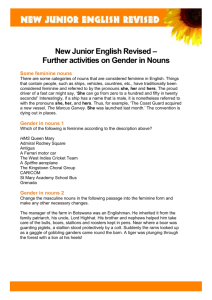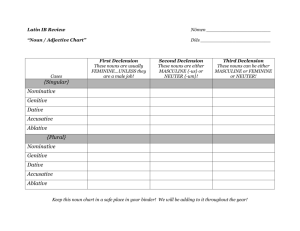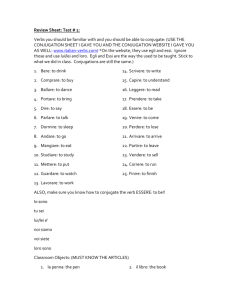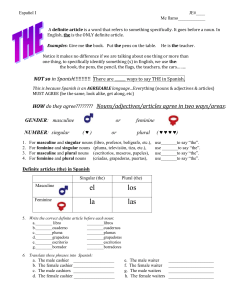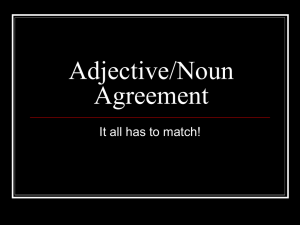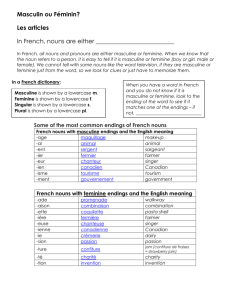Le Corps
advertisement
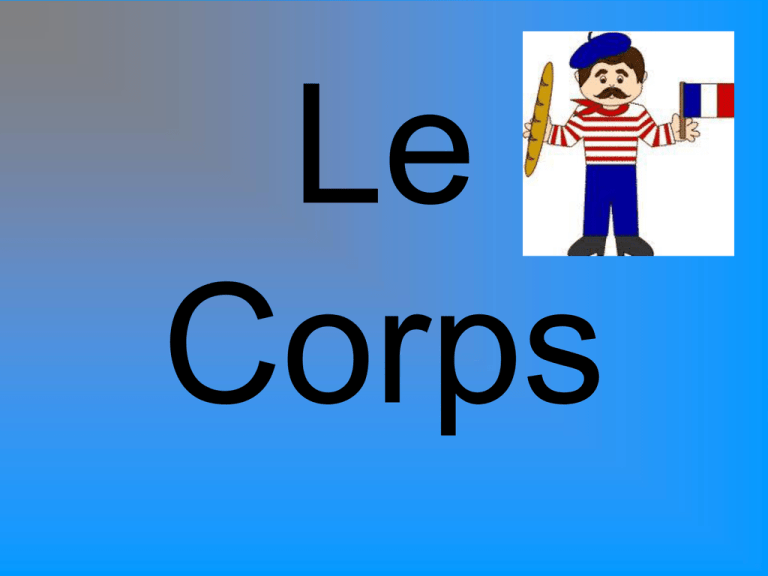
Le Corps La tête Le bras Le dos le ventre La jambe Le corps Definite articles (the) • A noun is a person, place, or thing. For example, a body part, such as the head, is a noun. • All French nouns have a special “identity”. They are either masculine or feminine. This does not mean they are boys and girls or that only boys can use the masculine and only girls can use the feminine, rather it is just a part of the word that must be acknowledged. There are 4 definite articles in French. • All 4 definite articles mean “the” in English. • When to use each one depends on whether the noun is masculine/feminine, singular/plural, and what the first letter of the noun is. Le: used before masculine, singular nouns beginning with a consonant other than “h” La: used before feminine, singular nouns beginning with a consonant other than “h” L’: used before masculine/feminine, singular nouns beginning with a vowel or :h” Les: used before all masculine/feminine, plural nouns La tête Les yeux L’oeil (m) Les cheveux (m) Le nez Les oreilles La bouche Le menton Le cou Le bras Le pouce L’épaule (f) Les doigts (m) La main Le coude La jambe Le genou La cheville L’orteil (m) Le doigt de pied Le pied Heads, Shoulders, Knees and Toes (in French!) Tête, épaules, genoux, pieds, genoux, pieds Tête, épaules, genoux, pieds, genoux, pieds Deux yeux, deux oreilles, une bouche et un nez Tête, épaules, genoux, pieds, genoux, pieds How the words sound Tett, ay-paul, zhehnoo pi-ay, zhehnoo pi-ay Tett, ay-paul zhehnoo pi-ay, zhehnoo piay Duhz yeuh duuz or-ays oon-a boosh ay unn nay Tett, ay-paul ay zhehnoo pi-ay, zhehnoo piay In French, adjectives normally have to agree with the nouns they modify in gender and number. Masc sing Fem sing Masc plural Fem plural Add “e” Add “s” Add “es” purple violet violette violets violettes blue bleu bleue bleus bleues green vert verte verts vertes yellow jaune jaune jaunes jaunes orange Orange** Orange** Orange** orange red rouge rouge rouges rouges black noir noire noirs noires white blanc blanche blancs blanches grey gris grise gris grises brown Marron** Marron** Marron** Marron** pink rose rose roses roses **French color adjectives derived from nouns, such as animals, flowers, fruits, gems, and metals, are usually invariable- they have a single form that does not change to reflect the gender or number of the noun : Most adjectives come after the noun He has a blue nose. She has purple eyes. He has a green mouth. It is necessary to have the article in front of all nouns unless you are using a number Il a le nez bleu. He has the nose blue. Elle a les yeux violets. She has the eyes purples. Il a la bouche verte. He has the mouth green. She has 3 black thumbs. Elle a trois pouces noirs. Jacques a dit • • • • • • • • frottez vos cheveux levez-vous asseyez-vous battez vos mains cliquez vos doigts frappez avec vos pieds ondulez vos bras touchez vos oreilles
